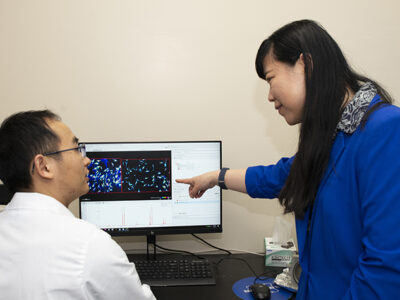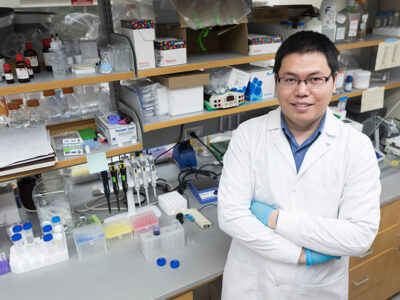
22
March

School of Pharmacy researchers reveal the crucial role of neuropeptides in cocaine addiction, paving the way for novel therapies
By Susan Smith
Why is cocaine so addictive, and why are treatments so ineffective? A new study out of the University of Wisconsin–Madison School of Pharmacy seeks those answers, finding that cocaine’s impact on the brain goes far beyond dopamine.
The study — a collaboration between the labs of Vilas Distinguished Achievement Professor of Pharmaceutical Sciences and Chemistry Lingjun Li and Professor of Psychiatry Brian Baldo — finds that a single dose of cocaine kicks off changes to a vast network of signaling neuropeptides in five important brain regions, giving a broader picture of how cocaine remodels the brain and suggesting some treatment targets. It was published in January in the Journal of ACS Chemical Neuroscience, an American Chemical Society publication.
Li explains that most of what is known about addiction in the brain has come from studying monoamine neurotransmitters, such as dopamine and serotonin. This is one of the first studies to use advanced mass spectrometry to comprehensively analyze changes in the brain’s neuropeptide system after cocaine exposure, rather than focusing on specific neuropeptides.

“I think the key message is that neuropeptides are really involved in a very complicated way,” says Li, who is also the Charles Melbourne Johnson Distinguished Chair in Pharmaceutical Sciences. “This is why the systems biology approach is so popular, because if you are just focusing on one pathway you may not be getting the full picture. Even the same neuropeptide molecule has different functions depending on where it is spatially located and where it is in the temporal process.”
Gaoyuan Lu, a Pharmaceutical Sciences graduate student in Li’s lab, led the study, using advanced mass spectrometry to identify and quantify the neuropeptide changes in five regions of the brain: the nucleus accumbens (responsible for feelings of motivation and reward), dorsal striatum (responsible for habit formation), prefrontal cortex (responsible for impulse control and decision-making), amygdala (which plays a key role in processing emotions like fear and anxiety), and hypothalamus (responsible for homeostasis and hormone regulation).
By comparing cocaine-dosed brains to a control group, the team identified changes in 1,376 peptides derived from 89 protein precursors. Earlier studies had identified about 50 affected peptides, but Li says that Lu’s improved sample preparation and more advanced mass spectrometry instrumentation resulted in a more refined look at the drug-induced changes.
The changes were specific to the brain regions, and peptides in the cholecystokinin (CCK) and melanin-concentrating hormone families (MCH) were most affected — both becoming key players in the substance misuse and addiction changes to the brain.
“The CCK family is classically shown to be linked to some drug use disorders, and these peptides were previously shown to be co-localized with dopamine,” he explained. “The second neuropeptide family, the MCH, are linked with stress and appetite, and we found elevated MCH in the hypothalamus, which might indicate a cocaine-induced metabolic response.”
These hormones are also known to be important to eating, reproduction, mood, circadian rhythm, higher cognition, energy balance, and reward-seeking behavior.
Li says these pathways may suggest new treatment strategies. One approach could be to develop drugs that mimic these altered neuropeptides or their receptors to help break the cycle of addiction.
“Knowing these answers will help us understand how the dependence can be reversed.”
—Lingjun Li
“In Gaoyuan’s work, we find some novel modifications of neuropeptides, so these could be promising new targets for addiction treatment by looking at designing peptidomimetics (synthetic peptides) and then looking at neuro receptor antagonists or agonists to manipulate the pathway,” Li says.
There are currently no effective treatments for cocaine addiction and deaths from cocaine abuse are on the rise. Li points out that the same CCK and MCH neuropeptide families are involved in addictive eating when they’re active in the nucleus accumbens, suggesting a shared biological mechanism between cocaine addiction and addictive eating behaviors.
“There are these overlapping neuropeptidergic systems that when we understand one addiction problem, it may help inform the other one,” she says. “So it’s quite interesting and meaningful.”
The team’s next study is already underway and involves looking at the changes in neuropeptides wrought by repeated doses of cocaine — a model of chronic cocaine addiction, followed by a withdrawal of the drug to simulate drug withdrawal symptoms.
“Future directions will include looking at the chronic drug use and withdrawal and looking at what additional neuropeptides or neuropeptidergic systems are responsible for a transition to drug dependence,” Li says. “Knowing these answers will help us understand how the dependence can be reversed.”





